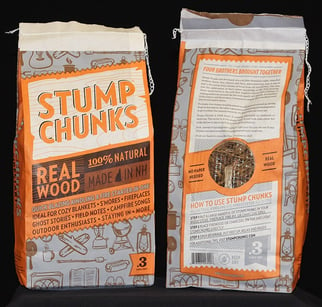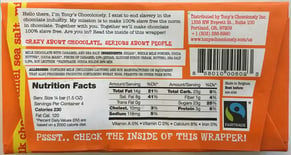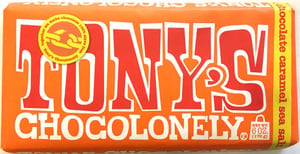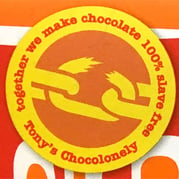How to Use Your Core Values to Inspire, Retain, and Energize Your Team
For the last few decades, but especially so in recent years, people are seeking out more than just an income from their place of employment. More...


Want to gain traction in the early stages of the customer’s journey? Here’s a tip: Step out of your shoes. Your audience wants to interact with someone who has walked a mile in their shoes. Add personality and customer aspirations to your product storytelling and you can unearth fresh, authentic ways to connect. It’s in there, right next to your passion, mission, and vision. Here's how two companies do just that to make “What’s in it for me?” crystal clear.
There’s a company in New Hampshire that sells chunks of wood, called Stump Chunks. I’ll tell you what it is about Stump Chunks that makes me drive out of my way to the one hardware store that carries them: Like most humans, I’m a sucker for good storytelling that resonates with what I want my life to look like. The Stump Chunks folks deftly enable their target audience to quickly see the answer to “What’s in it for me?” Here’s what works:
Express solutions as aspirational imagery
We all know the advantages of showing over telling when it comes to features and benefits. The folks at Stump Chunks have burnished their content and visuals to reflect the aspirational lifestyle of their target audience.
In New England, Old Man Winter owns the climate, teasing us only briefly with a summery respite (or “four months of bad sledding,” as the saying goes). We burn a lot of wood in the winter, and fire up the barbecue the minute the ice on the pond is too thin for skating.
One way to get the home fires burning quickly is to give it a jumpstart with “fatwood” – small chunks of wood harvested from old pine stumps that have a naturally high concentration of flammable resin, which makes starting a fire a breeze. That’s it. No toxic additives. Just sticks of wood, harvested as-is.
 The Stump Chunks packaging looks like a barbecue briquette bag (instead of a bland box like the other guys), with a good ol’ string-tear opening and a gusseted bottom that enables it to stand on its own. This ain't no flatlander firewood. This is a sturdy bag packed with Yankee practicality. With wry, well-aimed content and imagery, they turn that bag into a billboard of features and benefits that hit their target audience literally right where they wish they lived:
The Stump Chunks packaging looks like a barbecue briquette bag (instead of a bland box like the other guys), with a good ol’ string-tear opening and a gusseted bottom that enables it to stand on its own. This ain't no flatlander firewood. This is a sturdy bag packed with Yankee practicality. With wry, well-aimed content and imagery, they turn that bag into a billboard of features and benefits that hit their target audience literally right where they wish they lived:
Who knew there was such personality in them thar chunks? They warm me before I even have a chance to crack open the bag. I also appreciate their making the decision to purchase so enjoyable. It's worth it to go that extra mile to put your organizational personality into your branding efforts.
Show your roots
The idea of selling chunks of wood was born on a cold, New Hampshire night. I know this because the back of the bag tells how four brothers in New Hampshire overcame their own doubts about selling something as basic as chunks of wood. “It sounded too simple,” they muse. The bag goes on to describe how the wood is harvested, including a sustainability statement: “No trees were ever cut down expressly to make this product.”
The brothers’ story does sound “too simple,” but refreshingly so. You don’t need to overwork a good origin story, especially when there’s icing on the cake – in this case, a strong sustainability story. Again, it has nothing to do with the performance of the product. Instead, it’s a way of showing (not telling) their values and aspirations, and a way of earning some well-deserved brand loyalty with a target audience that shares those intangibles.
Across the pond in the Netherlands, Tony's Chocolonely has carved out a niche in the confectionary world: slave-free chocolate. Stops you in your tracks, doesn't it? It implies that the chocolate we've been chowing all this time has been the product of slavery. I, for one, couldn't help but read on.


I found Tony's Chocolonely when I was scanning the shelves of a local food co-op for chocolate that didn't cost $86 a pound (you'll find that one at eye level), when the bright and affordable Chocolonely wrapper caught my eye. "I exist to end slavery in the chocolate industry, together with you," it proclaimed. "Together we'll make chocolate 100% slave free. Are you in?" My taste buds and social consciousness sufficiently piqued, the bar and I headed home.
 I freed the bar from its wrapper (for research purposes) and read the story inside, where bit more information was laid out about the company's efforts and what inspired them to take on the chocolate industry. It was the perfect blend of simplicity and conviction; I got the gist of the story and in that quick read they earned my heartfelt support. A longer, more dense treatment might have lost me as I went about my busy day. A heavy-handed, guilt-inducing treatment might not have inspired me to visit their website to learn more.
I freed the bar from its wrapper (for research purposes) and read the story inside, where bit more information was laid out about the company's efforts and what inspired them to take on the chocolate industry. It was the perfect blend of simplicity and conviction; I got the gist of the story and in that quick read they earned my heartfelt support. A longer, more dense treatment might have lost me as I went about my busy day. A heavy-handed, guilt-inducing treatment might not have inspired me to visit their website to learn more.
It turns out that a journalist named Teun van de Keuken ("Teun" is the Dutch equivalent for "Tony") was horrified to discover that the production of chocolate relies heavily on slave labor, so he began his company. An unscientific taste test of the bar confirms that irresistible chocolate can be made without human suffering ... and not drain my grocery fund.
The impact of Tony's Chocolonely chocolate bars: Nearly 15 million pounds of cocoa beans bought directly from farmers, who earned over $1 million in extra premiums (on top of the Fairtrade premiums), and 28 million bars sold, bearing the message around the world. Now that's doing good done right, with a quality product at a fair price and a story a busy shopper can understand quickly.
Every product, service, or behavior change has a story. You can up the amperage of yours when you walk the proverbial mile in the shoes of your target audience to find fresh ways to add your own color, dimension, and personality. Stump Chunks and Tony's Chocolonely both hit all three with warmth and humor.
The Change Conversations blog is where changemakers find inspiration and insights on the power of mission-driven communication to create the change you want to see.
© 2009- to present, Marketing Partners, Inc. Content on the Change Conversations blog is licensed under a Creative Commons Attribution-Noncommercial-NoDerivs 3.0 United States License to share as much as you like. Please attribute to Change Conversations and link to ChangeConversations.
Creative Commons License may not apply to images used within posts and pages on this website. See hover-over or links for attribution associated with each image and licensing information.

For the last few decades, but especially so in recent years, people are seeking out more than just an income from their place of employment. More...

You know nonprofit organizations need websites just as small businesses do, but you may be surprised to learn nonprofit sites can be more complex and...

In today’s rapidly evolving media landscape, understanding where and how your story is told isn’t just strategic—it’s essential. How you communicate...